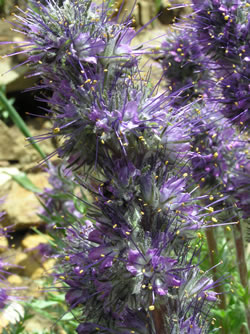Plant of the Week
 Range map of Phacelia sericea. States are colored green where the species may be found.
Range map of Phacelia sericea. States are colored green where the species may be found.
 Purple-flowered Phacelia sericea with yellow Senecio fremontii, from the Ophir Pass Road, Colorado. Photo by Al Schneider, Southwest Colorado Wildflowers.
Purple-flowered Phacelia sericea with yellow Senecio fremontii, from the Ophir Pass Road, Colorado. Photo by Al Schneider, Southwest Colorado Wildflowers.
 Phacelia sericea from Spiller-Helmet Ridge, Colorado. Photo by Al Schneider.
Phacelia sericea from Spiller-Helmet Ridge, Colorado. Photo by Al Schneider.
 Close-up of the inflorescence of Phacelia sericea. Photo by Al Schneider.
Close-up of the inflorescence of Phacelia sericea. Photo by Al Schneider.
Silky Phacelia (Phacelia sericea)
By Walter Fertig
With its thick stalks of dark blue or purple flowers and silvery-pubescent fern-like leaves, the silky phacelia (Phacelia sericea) is one of the handsomest wildflowers of western North America. No surprise then that it is often sought for cultivation in the home garden, not just in its native range from southern Canada to northern California, Utah, and Colorado, but elsewhere with sufficiently cool temperatures to promote germination. Planting silky phacelia not only enriches a garden with color, it might also repay the gardener with a tiny pot of gold.
English scientists Christine Girling and Peter Peterson sampled silky phacelia and other plants growing on alluvial soils within a gold-mining region of southern British Columbia and found that the phacelia was able to accumulate more gold within its tissues than the other species. Plants are known to take up many other commercially valuable minerals and are sometimes used as biological assays to prospect for new deposits. No one is likely to get rich off harvesting phacelias, however, as the plants only contained 21 parts per billion of gold (though this was significantly higher than the background amount of 1.6 ppb in the soil).
The genus Phacelia contains more than 150 species and is restricted to North and South America. The vast majority of species occur in desert areas of the western United States and northern Mexico. New species of Phacelia continue to be uncovered, with six being named just since 2007 by Duane Atwood of Brigham Young University. While most phacelia species are annuals or biennials, Silky phacelia is unusual in being a long-lived perennial from a woody base. Like other members of its genus, silky phacelia has flowers arranged in short clusters or fascicles (“phacelia” is from the Greek for fascicle) that are often coiled like the tail of a scorpion. The anthers of P. sericea are much longer than the bell-shaped corolla and help give the entire inflorescence a fuzzy appearance. The flowers are popular with bees.

